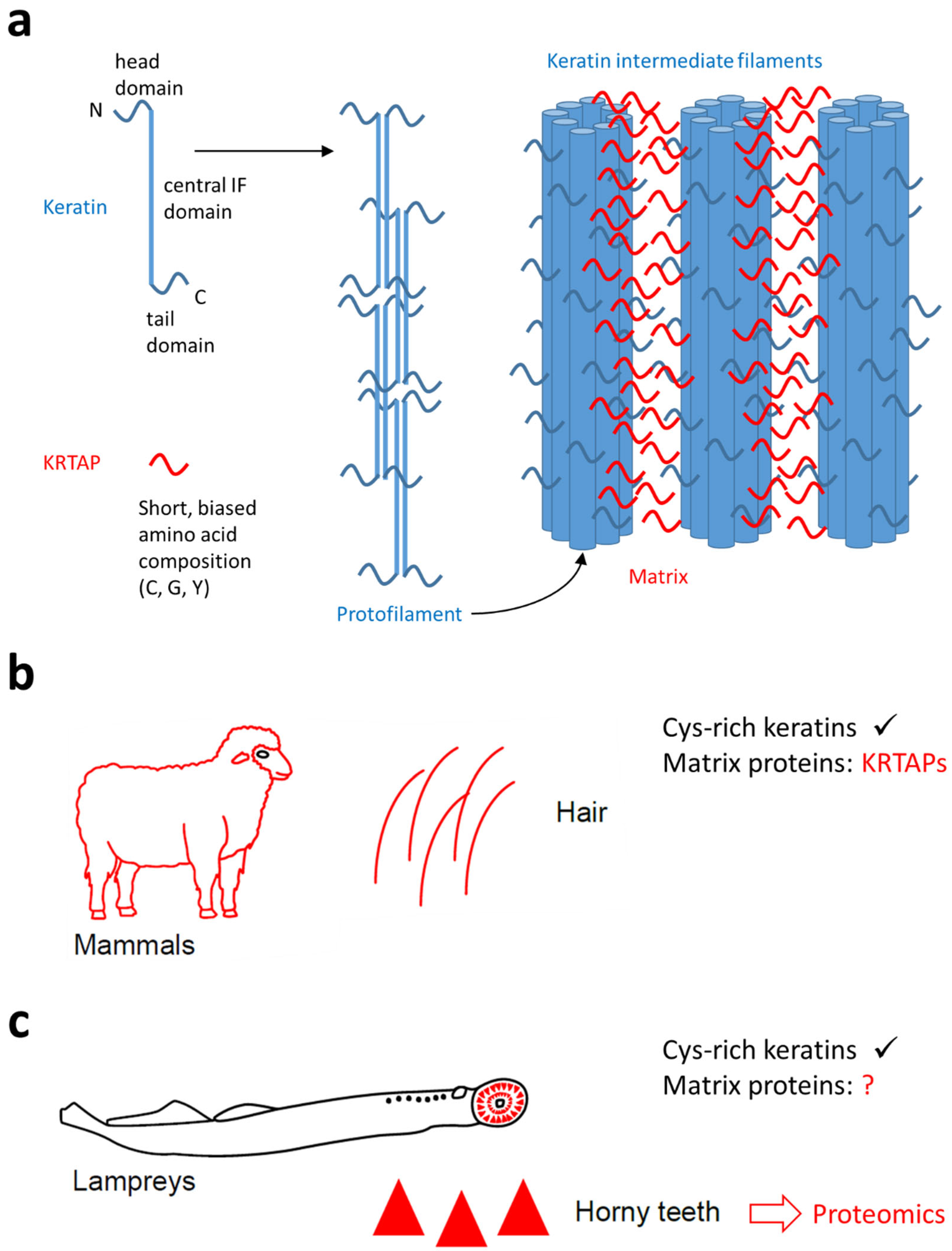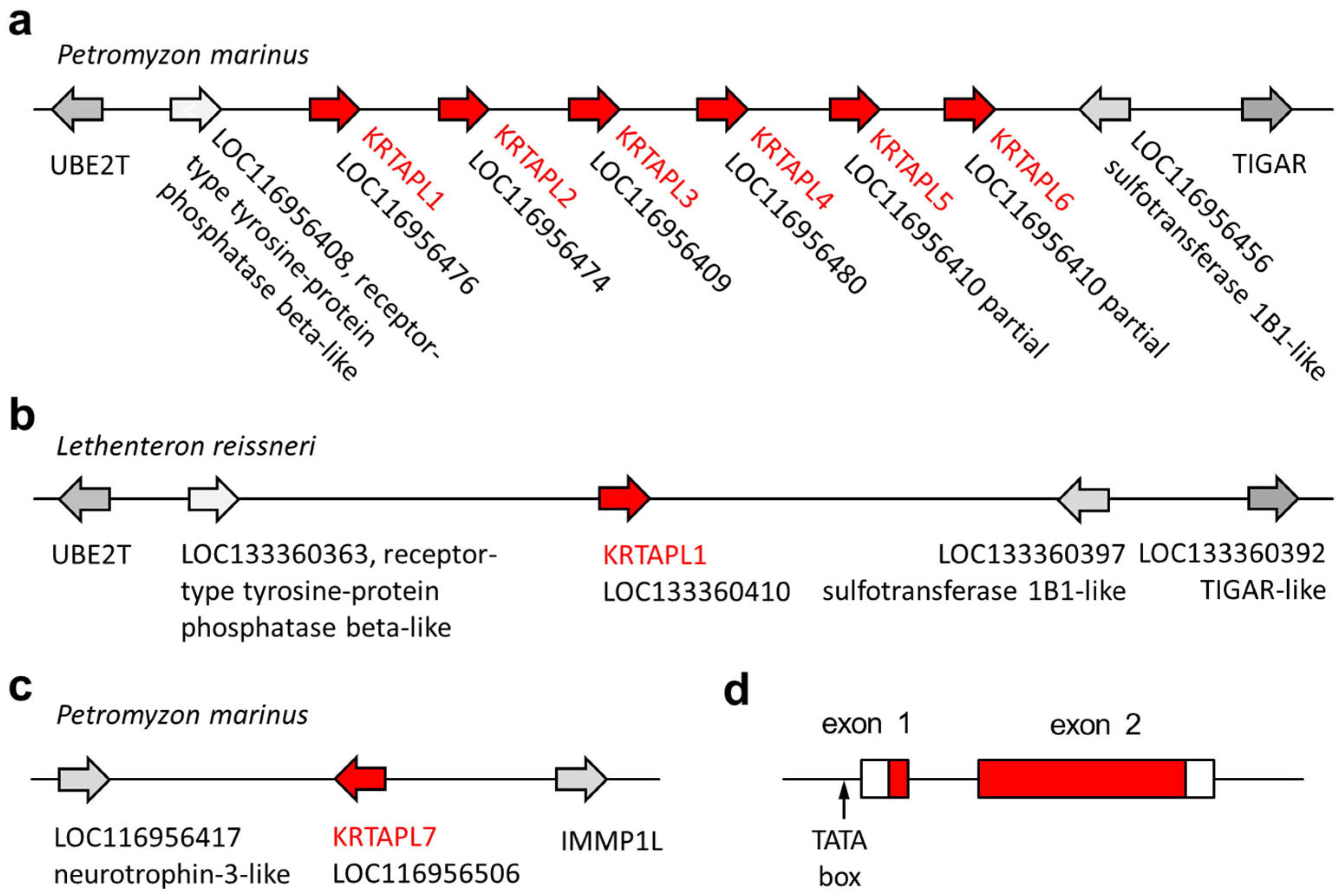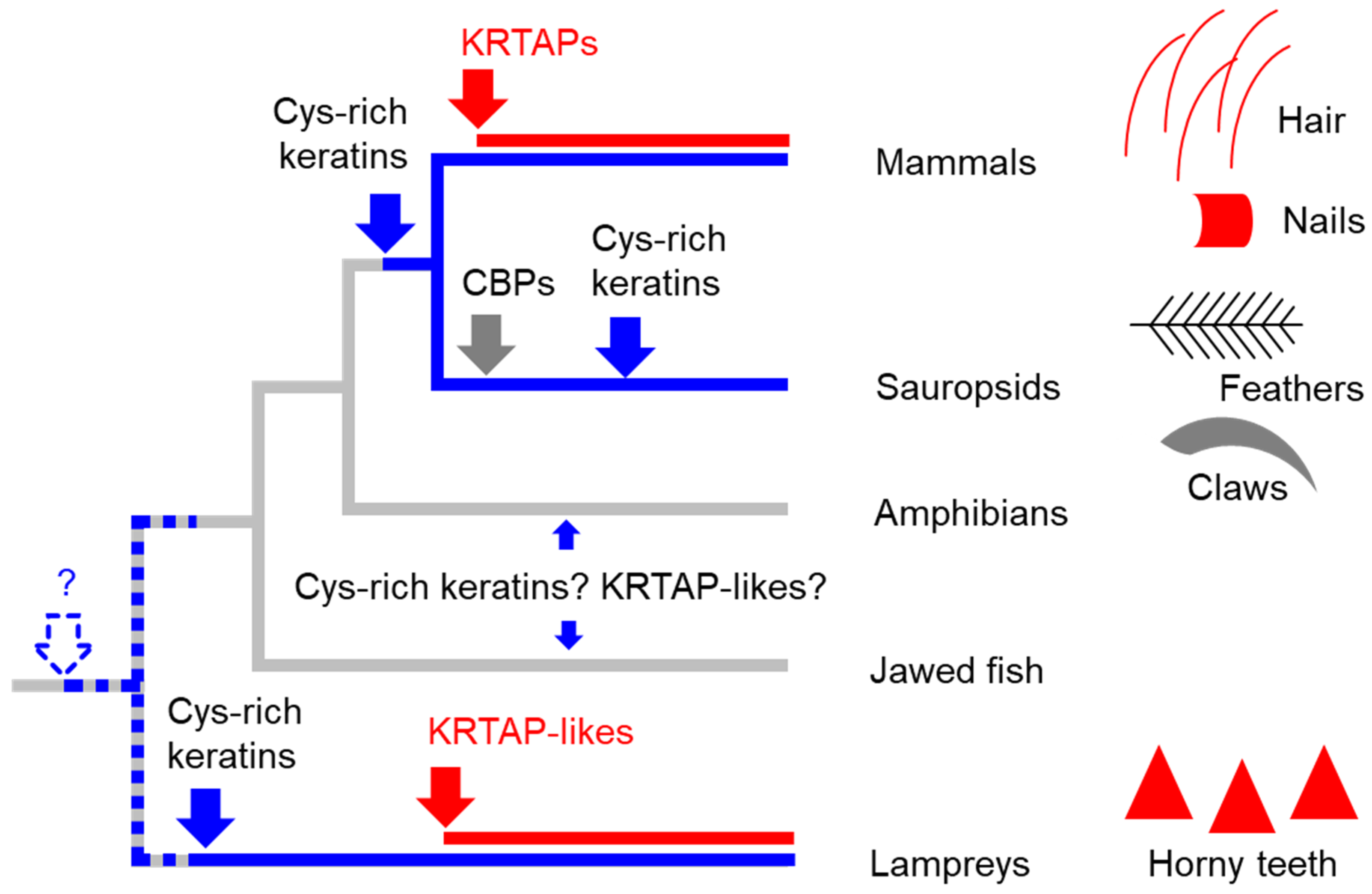Cornified Epithelial Teeth of Jawless Vertebrates Contain Proteins Similar to Keratin-Associated Proteins of Mammalian Skin Appendages
Abstract
1. Introduction
2. Materials and Methods
2.1. Comparative Genomics
2.2. Analysis of Proteome Data of Sea Lamprey
3. Results
3.1. Prediction of KRTAP-like Genes in Sea Lamprey
3.2. The Detection of KRTAP-like Proteins in the Horny Teeth of the Sea Lamprey
3.3. KRTAP-like Proteins of the Lamprey Are Rich in Glycine, Tyrosine, Cysteine, and Histidine
4. Discussion
Supplementary Materials
Author Contributions
Funding
Institutional Review Board Statement
Informed Consent Statement
Data Availability Statement
Acknowledgments
Conflicts of Interest
References
- Akat, E.; Yenmiş, M.; Pombal, M.A.; Molist, P.; Megías, M.; Arman, S.; Veselỳ, M.; Anderson, R.; Ayaz, D. Comparison of vertebrate skin structure at class level: A review. Anat. Rec. 2022, 305, 3543–3608. [Google Scholar] [CrossRef] [PubMed]
- Schempp, C.; Emde, M.; Wölfle, U. Dermatology in the Darwin anniversary. Part 1: Evolution of the integument. J. Dtsch. Dermatol. Ges. 2009, 7, 750–757. [Google Scholar] [CrossRef] [PubMed]
- Dhouailly, D. A new scenario for the evolutionary origin of hair, feather, and avian scales. J. Anat. 2009, 214, 587–606. [Google Scholar] [CrossRef] [PubMed]
- Holthaus, K.B.; Steinbinder, J.; Sachslehner, A.P.; Eckhart, L. Skin appendage proteins of tetrapods: Building blocks of claws, feathers, hair and other cornified epithelial structures. Animals 2025, 15, 457. [Google Scholar] [CrossRef]
- Alibardi, L. Keratinization and cornification are not equivalent processes but keratinization in fish and amphibians evolved into cornification in terrestrial vertebrates. Exp. Dermatol. 2022, 31, 794–799. [Google Scholar] [CrossRef]
- Maddin, H.C.; Eckhart, L.; Jaeger, K.; Russell, A.P.; Ghannadan, M. The anatomy and development of the claws of Xenopus laevis (Lissamphibia: Anura) reveal alternate pathways of structural evolution in the integument of tetrapods. J. Anat. 2009, 214, 607–619. [Google Scholar] [CrossRef]
- Alibardi, L. Cornification of the beak of Rana dalmatina tadpoles suggests the presence of basic keratin-associated proteins. Zool. Stud. 2010, 49, 51–63. [Google Scholar]
- Mittal, A.K.; Whitear, M. Keratinization of fish skin with special reference to the catfish Bagarius bagarius. Cell Tissue Res. 1979, 202, 213–230. [Google Scholar] [CrossRef]
- Fischer, B.; Metzger, M.; Richardson, R.; Knyphausen, P.; Ramezani, T.; Franzen, R.; Schmelzer, E.; Bloch, W.; Carney, T.J.; Hammerschmidt, M. p53 and TAp63 promote keratinocyte proliferation and differentiation in breeding tubercles of the zebrafish. PLoS Genet. 2014, 10, e1004048. [Google Scholar] [CrossRef]
- Scott, W.B. On the development of teeth in the lamprey. Science 1883, 2, 731–732. [Google Scholar] [CrossRef]
- Uehara, K.; Miyoshi, S.; Toh, H. Fine structure of the horny teeth of the lamprey, Entosphenus japonicus. Cell Tissue Res. 1983, 231, 1–15. [Google Scholar] [CrossRef] [PubMed]
- Alibardi, L.; Segalla, A. The process of cornification in the horny teeth of the lamprey involves proteins in the keratin range and other keratin-associated proteins. Zool. Stud. 2011, 50, 416–425. [Google Scholar]
- McCoy, V.E.; Saupe, E.E.; Lamsdell, J.C.; Tarhan, L.G.; McMahon, S.; Lidgard, S.; Mayer, P.; Whalen, C.D.; Soriano, C.; Finney, L.; et al. The ‘Tully monster’ is a vertebrate. Nature 2016, 532, 496–499. [Google Scholar] [CrossRef]
- Rice, R.H.; Rocke, D.M.; Tsai, H.S.; Silva, K.A.; Lee, Y.J.; Sundberg, J.P. Distinguishing mouse strains by proteomic analysis of pelage hair. J. Investig. Dermatol. 2009, 129, 2120–2125. [Google Scholar] [CrossRef][Green Version]
- Rice, R.H.; Xia, Y.; Alvarado, R.J.; Phinney, B.S. Proteomic analysis of human nail plate. J. Proteome Res. 2010, 9, 6752–6758. [Google Scholar] [CrossRef]
- Parry, D.A.D.; Smith, T.A.; Rogers, M.A.; Schweizer, J. Human hair keratin-associated proteins: Sequence regularities and structural implications. J. Struct. Biol. 2006, 155, 361–369. [Google Scholar] [CrossRef]
- Rogers, M.A.; Langbein, L.; Praetzel-Wunder, S.; Winter, H.; Schweizer, J. Human hair keratin-associated proteins (KAPs). Int. Rev. Cytol. 2006, 251, 209–263. [Google Scholar] [CrossRef]
- Gong, H.; Zhou, H.; McKenzie, G.W.; Yu, Z.; Clerens, S.; Dyer, J.M.; Plowman, J.E.; Wright, M.W.; Arora, R.; Bawden, C.S.; et al. An updated nomenclature for keratin-associated proteins (KAPs). Int. J. Biol. Sci. 2012, 8, 258–264. [Google Scholar] [CrossRef]
- Shibuya, K.; Kudoh, J.; Obayashi, I.; Shimizu, A.; Sasaki, T.; Minoshima, S.; Shimizu, N. Comparative genomics of the keratin-associated protein (KAP) gene clusters in human, chimpanzee, and baboon. Mamm. Genome 2004, 15, 179–192. [Google Scholar] [CrossRef]
- Wu, D.D.; Irwin, D.M.; Zhang, Y.P. Molecular evolution of the keratin associated protein gene family in mammals, role in the evolution of mammalian hair. BMC Evol. Biol. 2008, 8, 241. [Google Scholar] [CrossRef]
- Khan, I.; Maldonado, E.; Vasconcelos, V.; O’Brien, S.J.; Johnson, W.E.; Antunes, A. Mammalian keratin associated proteins (KRTAPs) subgenomes: Disentangling hair diversity and adaptation to terrestrial and aquatic environments. BMC Genom. 2014, 15, 779. [Google Scholar] [CrossRef] [PubMed]
- Wu, D.D.; Irwin, D.M. Evolution of trichocyte keratin associated proteins. Adv. Exp. Med. Biol. 2018, 1054, 47–56. [Google Scholar] [CrossRef] [PubMed]
- Eckhart, L.; Ehrlich, F. Evolution of trichocyte keratins. Adv. Exp. Med. Biol. 2018, 1054, 33–45. [Google Scholar] [CrossRef] [PubMed]
- Fujikawa, H.; Fujimoto, A.; Farooq, M.; Ito, M.; Shimomura, Y. Characterization of the human hair keratin-associated protein 2 (KRTAP2) gene family. J. Investig. Dermatol. 2012, 132, 1806–1813. [Google Scholar] [CrossRef]
- Harland, D.P.; McKinnon, A.J. Macrofibril Formation. Adv. Exp. Med. Biol. 2018, 1054, 155–169. [Google Scholar] [CrossRef]
- Harland, D.P.; Popescu, C.; Richena, M.; Deb-Choudhury, S.; Wichlatz, C.; Lee, E.; Plowman, J.E. The susceptibility of disulfide bonds to modification in keratin fibers undergoing tensile stress. Biophys. J. 2022, 121, 2168–2179. [Google Scholar] [CrossRef]
- Bendit, E.G.; Gillespie, J.M. The probable role and location of high-glycine-tyrosine proteins in the structure of keratins. Biopolymers 1978, 17, 2742–2745. [Google Scholar] [CrossRef]
- Fujimoto, S.; Takase, T.; Kadono, N.; Maekubo, K.; Hirai, Y. Krtap11-1, a hair keratin-associated protein, as a possible crucial element for the physical properties of hair shafts. J. Dermatol. Sci. 2014, 74, 39–47. [Google Scholar] [CrossRef]
- Gong, H.; Zhou, H.; Forrest, R.H.; Li, S.; Wang, J.; Dyer, J.M.; Luo, Y.; Hickford, J.G. Wool keratin-associated protein genes in sheep-a review. Genes 2016, 7, 24. [Google Scholar] [CrossRef]
- Fraser, R.D.B.; Parry, D.A.D. Trichocyte keratin-associated proteins (KAPs). Adv. Exp. Med. Biol. 2018, 1054, 71–86. [Google Scholar] [CrossRef]
- Sachslehner, A.P.; Eckhart, L. Convergent evolution of cysteine-rich keratins in horny teeth of jawless vertebrates and in cornified skin appendages of amniotes. Mol. Biol. Evol. 2025, 42, msaf028. [Google Scholar] [CrossRef] [PubMed]
- Corden, L.D.; McLean, W.H. Human keratin diseases: Hereditary fragility of specific epithelial tissues. Exp. Dermatol. 1996, 5, 297–307. [Google Scholar] [CrossRef] [PubMed]
- Alibardi, L.; Toni, M.; Dalla Valle, L. Hard cornification in reptilian epidermis in comparison to cornification in mammalian epidermis. Exp. Dermatol. 2007, 16, 961–976. [Google Scholar] [CrossRef]
- Steinert, P.M.; Cantieri, J.S.; Teller, D.C.; Lonsdale-Eccles, J.D.; Dale, B.A. Characterization of a class of cationic proteins that specifically interact with intermediate filaments. Proc. Natl. Acad. Sci. USA 1981, 78, 4097–4101. [Google Scholar] [CrossRef]
- Takase, T.; Hirai, Y. Identification of the C-terminal tail domain of AHF/trichohyalin as the critical site for modulation of the keratin filamentous meshwork in the keratinocyte. J. Dermatol. Sci. 2012, 65, 141–148. [Google Scholar] [CrossRef]
- Ehrlich, F.; Lachner, J.; Hermann, M.; Tschachler, E.; Eckhart, L. Convergent evolution of cysteine-rich keratins in hard skin appendages of terrestrial vertebrates. Mol. Biol. Evol. 2020, 37, 982–993. [Google Scholar] [CrossRef]
- Zhu, T.; Li, Y.; Pang, Y.; Han, Y.; Li, J.; Wang, Z.; Liu, X.; Li, H.; Hua, Y.; Jiang, H.; et al. Chromosome-level genome assembly of Lethenteron reissneri provides insights into lamprey evolution. Mol. Ecol. Resour. 2021, 21, 448–463. [Google Scholar] [CrossRef]
- Madeira, F.; Madhusoodanan, N.; Lee, J.; Eusebi, A.; Niewielska, A.; Tivey, A.R.N.; Lopez, R.; Butcher, S. The EMBL-EBI Job Dispatcher sequence analysis tools framework in 2024. Nucleic Acids Res. 2024, 52, W521–W525. [Google Scholar] [CrossRef]
- Corpet, F. Multiple sequence alignment with hierarchical clustering. Nucleic Acids Res. 1988, 16, 10881–10890. [Google Scholar] [CrossRef]
- Sachslehner, A.P.; Surbek, M.; Holthaus, K.B.; Steinbinder, J.; Golabi, B.; Hess, C.; Eckhart, L. The evolution of transglutaminases underlies the origin and loss of cornified skin appendages in vertebrates. Mol. Biol. Evol. 2024, 41, msae100. [Google Scholar] [CrossRef]
- Smith, J.J.; Timoshevskaya, N.; Ye, C.; Holt, C.; Keinath, M.C.; Parker, H.J.; Cook, M.E.; Hess, J.E.; Narum, S.R.; Lamanna, F.; et al. The sea lamprey germline genome provides insights into programmed genome rearrangement and vertebrate evolution. Nat. Genet. 2018, 50, 270–277. [Google Scholar] [CrossRef] [PubMed]
- Timoshevskaya, N.; Eşkut, K.I.; Timoshevskiy, V.A.; Robb, S.M.C.; Holt, C.; Hess, J.E.; Parker, H.J.; Baker, C.F.; Miller, A.K.; Saraceno, C.; et al. An improved germline genome assembly for the sea lamprey Petromyzon marinus illuminates the evolution of germline-specific chromosomes. Cell Rep. 2023, 42, 112263. [Google Scholar] [CrossRef]
- Hughes, L.C.; Bloom, D.D.; Piller, K.R.; Lang, N.; Mayden, R.L. Phylogenomic resolution of lampreys reveals the recent evolution of an ancient vertebrate lineage. Proc. Biol. Sci. 2025, 292, 20242101. [Google Scholar] [CrossRef]
- Matsunaga, R.; Abe, R.; Ishii, D.; Watanabe, S.; Kiyoshi, M.; Nöcker, B.; Tsuchiya, M.; Tsumoto, K. Bidirectional binding property of high glycine-tyrosine keratin-associated protein contributes to the mechanical strength and shape of hair. J. Struct. Biol. 2013, 183, 484–494. [Google Scholar] [CrossRef]
- Deb-Choudhury, S. Crosslinking between trichocyte keratins and keratin associated proteins. Adv. Exp. Med. Biol. 2018, 1054, 173–183. [Google Scholar] [CrossRef]
- Zhou, H.; Gong, H.; Wang, J.; Luo, Y.; Li, S.; Tao, J.; Hickford, J.G.H. The complexity of the ovine and caprine keratin-associated protein genes. Int. J. Mol. Sci. 2021, 22, 12838. [Google Scholar] [CrossRef]
- Plowman, J.E. Diversity of trichocyte keratins and keratin associated proteins. Adv. Exp. Med. Biol. 2018, 1054, 21–32. [Google Scholar]
- Stein, W.D.; Hoshen, M.B. During evolution from the earliest tetrapoda, newly-recruited genes are increasingly paralogues of existing genes and distribute non-randomly among the chromosomes. BMC Genom. 2021, 22, 794. [Google Scholar] [CrossRef]
- Litman, T.; Stein, W.D. Ancient lineages of the keratin-associated protein (KRTAP) genes and their co-option in the evolution of the hair follicle. BMC Ecol. Evol. 2023, 23, 7. [Google Scholar] [CrossRef]
- Alibardi, L. Immunolabeling indicates that sulfhydryl oxidase is absent in anamniote epidermis but marks the process of cornification in the skin of terrestrial vertebrates. J. Morphol. 2021, 282, 247–261. [Google Scholar] [CrossRef]
- Alibardi, L. Structural and immunocytochemical characterization of keratinization in vertebrate epidermis and epidermal derivatives. Int. Rev. Cytol. 2006, 253, 177–259. [Google Scholar] [CrossRef] [PubMed]
- Rechiche, O.; Plowman, J.E.; Harland, D.P.; Lee, T.V.; Lott, J.S. Expression and purification of high sulfur and high glycine-tyrosine keratin-associated proteins (KAPs) for biochemical and biophysical characterization. Protein Expr. Purif. 2018, 146, 34–44. [Google Scholar] [CrossRef] [PubMed]
- Zhou, Q.; Toivola, D.M.; Feng, N.; Greenberg, H.B.; Franke, W.W.; Omary, M.B. Keratin 20 helps maintain intermediate filament organization in intestinal epithelia. Mol. Biol. Cell 2003, 14, 2959–2971. [Google Scholar] [CrossRef]
- Wong, P.; Domergue, R.; Coulombe, P.A. Overcoming functional redundancy to elicit pachyonychia congenita-like nail lesions in transgenic mice. Mol. Cell. Biol. 2005, 25, 197–205. [Google Scholar] [CrossRef]





| Protein | Peptide Sequence | Unique | Percolator q-Value (by Search Engine): Sequest HT | Percolator PEP (by Search Engine): Sequest HT |
|---|---|---|---|---|
| KRTAPL1 | SPCCTPCPPCVPK | yes | 0.0003848 | 3.31 × 10−7 |
| TVVAGGYGGYGGYGYAGK | no | 0.0003848 | 7.20 × 10−9 | |
| TVVAGGYGGYGGYGYAGKY | no | 0.0003848 | 5.45 × 10−8 | |
| GCVSPCAPR | no | 0.0003848 | 5.29 × 10−4 | |
| KCEPCPVTK | no | 0.0003848 | 1.26 × 10−3 | |
| SKSPCCTPCPPCVPK | yes | 0.001314 | 5.41 × 10−3 | |
| FKGCPSPCR | no | 0.001496 | 6.00 × 10−3 | |
| KRTAPL2 | SPCCTPAPK | yes | 0.0003848 | 1.92 × 10−4 |
| SPCCTPCPPCVPK | no | 0.0003848 | 3.31 × 10−7 | |
| TVVAGGYGGYGGYGYAGK | no | 0.0003848 | 7.20 × 10−9 | |
| TVVAGGYGGYGGYGYAGKY | no | 0.0003848 | 5.45 × 10−8 | |
| GCVSPCAPR | no | 0.0003848 | 5.29 × 10−4 | |
| KCEPCPVTK | no | 0.0003848 | 1.26 × 10−3 | |
| FKGCPSPCR | no | 0.001496 | 6.00 × 10−3 | |
| KRTAPL3 | SPCCTPCPPCVPK | no | 0.0003848 | 3.31 × 10−7 |
| TVVAGGYGGYGGYGGYGYAGKY | yes | 0.0003848 | 3.59 × 10−10 | |
| GCVSPCAPR | no | 0.0003848 | 5.29 × 10−4 | |
| KCEPCPVTK | no | 0.0003848 | 1.26 × 10−3 | |
| FKGCPSPCR | no | 0.001496 | 6.00 × 10−3 | |
| KRTAPL6 | SSCHHCGGVGCGHCR | yes | 0.0003848 | 3.85 × 10−6 |
| CGGIGCGHCR | yes | 0.0003848 | 1.26 × 10−6 | |
| KRTAPL7 | VYGVTHHVGR | yes | 0.0003848 | 7.14 × 10−6 |
| FGHGGGFGAVCGLNAVSAVPSR * | yes | 0.0003848 | 4.00 × 10−17 | |
| FGHGGGFGAVCGLNAVSAVPSR * | yes | 0.0003848 | 3.27 × 10−17 | |
| FGHGGGFGAVCGLNAVSAVPSRSYYSVAPLGR | yes | 0.0003848 | 6.14 × 10−5 | |
| SYYSVAPLGR | yes | 0.0007115 | 3.06 × 10−3 |
| Protein: | KRTAPL1 | KRTAPL2 | KRTAPL3 | KRTAPL4 | KRTAPL5 | KRTAPL6 | KRTAPL7 | KRTAP5-1 | KRTAP19-1 | |
|---|---|---|---|---|---|---|---|---|---|---|
| Species: | Lamprey | Lamprey | Lamprey | Lamprey | Lamprey | Lamprey | Lamprey | Human | Human | |
| aa residues: | 188 | 199 | 173 | 147 | 165 | 310 | 220 | 278 | 90 | |
| Mw (kD): | 18,942 | 20,199 | 17,425 | 14,964 | 16,476 | 32,323 | 21,436 | 24,194 | 9008 | |
| pI: | 8.50 | 8.51 | 8.73 | 7.98 | 8.36 | 8.78 | 9.03 | 8.39 | 8.45 | |
| aa composition: | ||||||||||
| Ala | A | 6.4% | 6.5% | 6.9% | 2.7% | 1.8% | 1.0% | 8.6% | 1.1% | 0.0% |
| Arg | R | 2.1% | 2.0% | 2.3% | 0.0% | 4.2% | 11.3% | 4.5% | 0.4% | 3.3% |
| Asn | N | 0.5% | 0.5% | 0.6% | 0.0% | 0.0% | 0.0% | 1.4% | 0.0% | 1.1% |
| Asp | D | 0.5% | 1.0% | 0.0% | 2.7% | 1.2% | 1.6% | 0.9% | 0.0% | 0.0% |
| Cys | C | 6.9% | 8.5% | 7.5% | 8.8% | 9.1% | 21.9% | 6.4% | 30.6% | 7.8% |
| Gln | Q | 1.6% | 2.0% | 1.7% | 8.2% | 0.6% | 1.0% | 0.9% | 1.4% | 0.0% |
| Glu | E | 2.7% | 2.5% | 2.3% | 2.7% | 1.2% | 3.5% | 0.5% | 0.0% | 0.0% |
| Gly | G | 30.9% | 26.6% | 30.6% | 29.9% | 36.4% | 23.2% | 31.8% | 31.7% | 42.2% |
| His | H | 9.6% | 9.0% | 9.2% | 13.6% | 15.8% | 13.9% | 7.3% | 0.0% | 1.1% |
| Ile | I | 0.0% | 0.5% | 0.0% | 1.4% | 1.2% | 0.6% | 0.5% | 0.4% | 0.0% |
| Leu | L | 1.6% | 1.5% | 2.3% | 1.4% | 3.0% | 1.0% | 3.6% | 0.0% | 2.2% |
| Lys | K | 3.7% | 4.5% | 4.0% | 6.8% | 0.6% | 2.6% | 1.4% | 6.1% | 0.0% |
| Met | M | 1.6% | 1.5% | 0.6% | 2.0% | 0.6% | 0.3% | 0.9% | 0.7% | 1.1% |
| Phe | F | 0.5% | 0.5% | 0.6% | 1.4% | 1.8% | 1.3% | 3.2% | 0.0% | 7.8% |
| Pro | P | 7.4% | 9.5% | 7.5% | 0.7% | 1.2% | 0.0% | 3.6% | 3.6% | 1.1% |
| Ser | S | 3.7% | 4.0% | 4.0% | 4.8% | 6.7% | 10.6% | 8.6% | 19.8% | 12.2% |
| Thr | T | 4.8% | 5.0% | 3.5% | 2.0% | 4.2% | 1.3% | 2.3% | 0.4% | 0.0% |
| Trp | W | 0.0% | 0.0% | 0.0% | 0.7% | 0.0% | 0.3% | 1.8% | 0.0% | 0.0% |
| Tyr | Y | 12.8% | 11.1% | 13.3% | 4.8% | 9.1% | 0.3% | 6.8% | 0.0% | 20.0% |
| Val | V | 2.7% | 3.0% | 2.9% | 5.4% | 1.2% | 4.2% | 5.0% | 4.0% | 0.0% |
Disclaimer/Publisher’s Note: The statements, opinions and data contained in all publications are solely those of the individual author(s) and contributor(s) and not of MDPI and/or the editor(s). MDPI and/or the editor(s) disclaim responsibility for any injury to people or property resulting from any ideas, methods, instructions or products referred to in the content. |
© 2025 by the authors. Licensee MDPI, Basel, Switzerland. This article is an open access article distributed under the terms and conditions of the Creative Commons Attribution (CC BY) license (https://creativecommons.org/licenses/by/4.0/).
Share and Cite
Sachslehner, A.P.; Parry, D.A.D.; Eckhart, L. Cornified Epithelial Teeth of Jawless Vertebrates Contain Proteins Similar to Keratin-Associated Proteins of Mammalian Skin Appendages. J. Dev. Biol. 2025, 13, 18. https://doi.org/10.3390/jdb13020018
Sachslehner AP, Parry DAD, Eckhart L. Cornified Epithelial Teeth of Jawless Vertebrates Contain Proteins Similar to Keratin-Associated Proteins of Mammalian Skin Appendages. Journal of Developmental Biology. 2025; 13(2):18. https://doi.org/10.3390/jdb13020018
Chicago/Turabian StyleSachslehner, Attila Placido, David A. D. Parry, and Leopold Eckhart. 2025. "Cornified Epithelial Teeth of Jawless Vertebrates Contain Proteins Similar to Keratin-Associated Proteins of Mammalian Skin Appendages" Journal of Developmental Biology 13, no. 2: 18. https://doi.org/10.3390/jdb13020018
APA StyleSachslehner, A. P., Parry, D. A. D., & Eckhart, L. (2025). Cornified Epithelial Teeth of Jawless Vertebrates Contain Proteins Similar to Keratin-Associated Proteins of Mammalian Skin Appendages. Journal of Developmental Biology, 13(2), 18. https://doi.org/10.3390/jdb13020018







